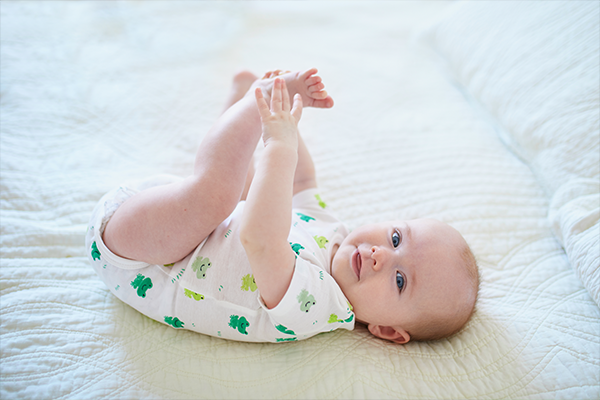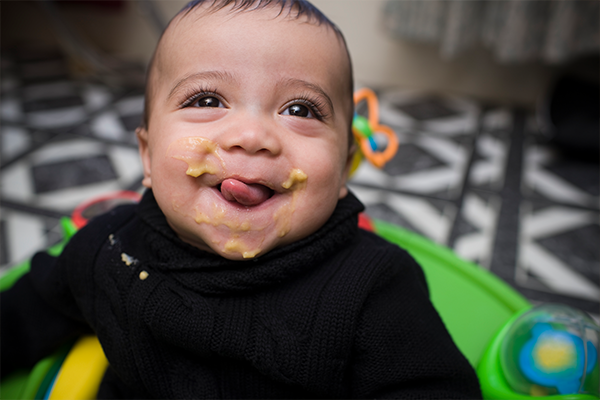Baby Laughing and Crying at the Same Time Concerns
Large strides in development happen between 4-half dozen months old. That's because the left side of the brain is now "talking" to the right side of the brain. Your baby may begin to stone back and forth to prepare for crawling by moving the artillery and legs together or pass a toy from i mitt to the other. Babies at this historic period are learning how to interact with the world effectually them. To get your attending, your baby might cry, fuss or squeal. To get a better view of the room, babies may use newfound strength to pull upwardly on their arms while lying on the belly.
Developmental Milestones
Doctors use milestones to tell if a baby is developing as expected. In that location'due south a wide range of what's considered normal for 4-calendar month and 6-calendar month-one-time development, so some babies gain skills earlier or later than others. Babies who were born prematurely may accomplish milestones afterwards. Always talk with your medico about your baby's progress, especially if there are concerns.
How much will my 4- to 6-calendar month-old babe grow?
While all babies may grow at a unlike rate, the following indicates the average for boys and girls four to 6 months of age:
- Weight: average gain of 1 to i¼ pounds each month; by four to five months has doubled birthweight
- Height: average growth of ½ to one inch each calendar month
- Head size: boilerplate growth of almost ½ inch each calendar month
What tin my baby do at this age?
This age is very social and babies begin moving in much more purposeful ways. While babies may progress at different rates, the following are some of the common milestones your baby may reach in this age group:
- Grasp, Moro, root and tonic neck reflexes (reflexes ordinarily present in young infants) disappear
- Balances head well
- Sits with back up, back is rounded
- Begins to back up trunk with legs when held in standing position
- Rolls from dorsum to front and front to back past 6 months
- Moves object from one hand to other
- Grabs feet and toes when lying on back
- Makes "swimming" motions with arms and legs when placed on abdomen
- Begins drooling (not ever a sign of teething)
- Naps 2 to three times a mean solar day, for one to three hours each (on average)
- Begins to sleep longer at dark (half dozen to eight hours consistently)
- Has full colour vision, able to see at longer distances

Why is impact important for development at four- to six-months-onetime?
Babies acquire most the world through touch. When you lot cuddle or kiss your infant, your infant learns that he or she is safe, secure and loved.
The opportunities for exercising your baby's sense of touch at this age are endless, even during a regular day. Your baby volition enjoy toys and books with unlike textures. Let your baby to safely explore surroundings. See if your baby likes to touch on the silky trim of the baby blanket or experience the texture of a carpet.
How long should my iv- to half-dozen-month-sometime infant sleep?
By this age, your infant should be well on the mode toward having a regular sleep pattern. Some infants, peculiarly those who are breastfed, may notwithstanding wake at night, but most no longer need a middle of the nighttime feeding.
Most babies at this historic period should sleep 12-16 hours a day, which includes a longer stretch at night and at least two naps during the 24-hour interval, says the National Slumber Foundation. The average amount of daytime sleep is now almost 3-iv hours. Past 6 months, virtually babies are sleeping at night for 9 hours or longer, with brief awakenings.
Bank check out our good for you sleep guide for babies to get more than info.
How can I aid increment my infant's development and emotional security?
Consider the following as ways to foster the emotional security of your baby:
- Repeat sounds and smile when your infant makes sounds.
- Laugh with your baby.
- Talk to and imitate your baby during feeding, dressing, changing diapers and bath time.
- Spend time on the flooring playing with your child every mean solar day.
- Trip the light fantastic toe with your baby and exercise other rhythmic movements.
- Introduce your babe to other children and parents.
- Place safe toys nearly your baby to encourage reaching and grasping.
- Encourage laughing and play by making funny faces or sounds or blowing on infant's belly and laughing.
- Play peek-a-boo games to help develop object permanence, the understanding that objects are withal present even though they cannot be seen.
- Show your infant vivid picture books and interesting objects.
- Show your baby his or her reflection in a mirror.
- Read books and stories to your babe, and betoken out pictures.
- Take your baby outside to run into new things and people.
- Concord your baby for feedings and cuddle when he or she is awake.
- Hold and condolement your babe when he or she is unhappy.
Communication and Sensory Milestones
What can my infant say?
Your baby's range of sounds and facial expressions continues to abound, with lots of smiling, laughing and babbling. Your infant is too imitating sounds, which is an of import skill for learning to talk. It is very heady for parents to watch their babies become social beings that can collaborate with others. While every baby develops spoken communication at his or her ain charge per unit, the following are some of the mutual milestones in this age grouping:
- Coos and gurgles when talked to, or in response to toys
- Babbles, imitates sounds
- Past six months, makes single syllable sounds (da, ma, ba)
- Laughs
- Squeals
- Blows bubbling or "raspberries"
How practice babies at 4-vi months communicate?
Babies this age begin to experiment with the sounds they can make with their mouths. Your baby volition spend more than time babbling and imitate sounds. These are your baby's early attempts at speaking and should be encouraged every bit much as possible.
If you heed closely, you'll hear your babe'southward voice rise and drib equally if asking a question or making a statement. Your baby will too apply sounds (other than crying) to go your attention and express feelings.
Your baby is just at present showtime to understand the fundamentals of communication through language. When your baby was younger, they understood what you meant through the tone of your vocalism: soothing tones were comforting while agitated tones signaled something was wrong.
Now, your baby is beginning to pick out the components of your voice communication. They can hear and sympathize the different sounds you brand, and the fashion words form sentences. During this period, babies acquire to respond to their names, may suspension when they hear "no," and will start to associate words with familiar objects.
What does my 4- to half-dozen-calendar month-sometime baby understand?
A baby's awareness of people and surround increases during this fourth dimension and he or she may brainstorm to interact with people other than parents. While babies may progress at dissimilar rates, the following are some of the common milestones in this age group:
- Recognize familiar things and people
- May hold out arms to be picked upwardly
- Begin to learn concept of object permanence (i.e., a partially hidden object under a blanket is all the same there)
- May show displeasure when object or person goes away
- May recognize his or her own name
- May begin to understand "no" at 6 months of age
- Begin to understand cause and effect (the sound a toy makes when it is dropped)
What tin can my four- to 6-calendar month-one-time baby see?
Babies at this age can see much farther away (several feet) than merely a few months agone. They tin usually focus without going cantankerous-eyed and tin tell the difference between unlike colors.
Your baby is condign much more aware of the environment. He or she can at present follow the course of a rolling ball and watch the quick movements of an older sibling playing nearby. You may encounter your infant staring in concentration while holding a toy or studying his or her own easily. Mitt-eye coordination is improving, so watch as your trivial 1 stares for a while at an object, then slowly reaches out to go it.
Assist amend your babe's sight skills with these tips:
- If your infant has been looking at the same toys or crib mobile for several months, at present is a good time to change the scenery. Around 6 months, some babies get-go to pull themselves upward to a sitting position. We recommend removing mobiles that hang over the crib or wall hangings within reach, so your baby doesn't get injure.
- Babies at this historic period savor more than complex patterns and color variations. Try reading books with large, brightly colored pictures to your baby, who volition bask staring at the pages.
- Stimulate your baby'due south vision past exploring. Walks in the neighborhood, a trip to the supermarket or an outing to the local zoo all provide wonderful opportunities for your baby to see new things.
What tin my iv- to 6-month-old infant hear?
Hearing is crucial to developing the power to talk, and now your infant is beginning to pick out the parts of speech communication. Babies at this age as well are cooing and may first to blubbering and brand more attempts to imitate sounds.
These are your baby's early attempts at speaking and should be encouraged as much every bit possible. Parents should repeat sounds their baby makes and innovate simple words that apply to everyday life. Have "conversations" with your infant and wait for a suspension in the babble to "answer." The give-and-take of these early on discussions sets the phase for your babe'southward first real words.
What can my 4- to six-month-old baby taste and odor?
Your baby can taste and smell at this historic period. iv- to half dozen-month-former babies will prefer sugariness tasting items over bitter ones. Yet, their taste preferences continue to grow and modify. Babies volition likewise begin recognizing smells they similar and turning abroad from bad odors. If a mother is breastfeeding, it's likely that a female parent's nutrition can shape the baby's flavour preferences in the long run.
Feeding Milestones
Most babies at this age try solid foods like oatmeal, cereal or some other unmarried-grain cereal. Experts recommend slowly starting solid foods when a baby is about 6 months old, depending on the babe's readiness and nutritional needs. Be sure to check with your medico earlier giving whatsoever solid foods.

Is my baby ready to eat solid foods?
Hither are a few questions to enquire if your infant is ready for solids:
- Is your infant'due south tongue-thrust reflex gone or diminished? This reflex, which prevents infants from choking, besides causes them to push food out of their mouths.
- Tin can your baby support his or her own caput? To eat solid food, an infant needs good caput and neck control and should be able to sit upwards supported.
- Is your baby interested in food? A six-calendar month-onetime infant who stares and grabs at your food at dinnertime is clearly gear up for some variety in the food department.
If your doctor gives the go-ahead merely your baby seems frustrated or uninterested equally yous're introducing solid foods, endeavour waiting a few days or fifty-fifty weeks before trying once again. Solids are only a supplement at this point — breast milk and formula volition withal meet your babe's basic nutritional needs.
Tips for Feeding Your Baby Solid Foods
With the hectic footstep of family life, most parents opt for commercially prepared baby foods at outset. They come in small, convenient containers, and manufacturers must see strict safety and nutrition guidelines. When buying these pre-packaged foods, try to avoid brands with added fillers and sugars.
If you do program to fix your own baby foods at home, puréeing them with a food processor or blender, here are some things to go on in mind:
- Follow the rules for food safety, including washing your hands well and often.
- To preserve the nutrients in your baby's nutrient, use cooking methods that keep the most vitamins and minerals. Try steaming or baking fruits and vegetables instead of boiling, which washes abroad the nutrients.
- Freeze portions that you lot aren't going to employ right away rather than canning them.
- Don't serve home-prepared beets, spinach, greenish beans, squash, or carrots to infants younger than 4 months old. These can comprise high levels of nitrates, which can cause anemia in babies. Utilise jarred varieties of these vegetables instead.
- Whether you buy the infant nutrient or make it yourself, texture and consistency are important. At kickoff, babies should have finely puréed single-ingredient foods. For instance, at outset endeavour just applesauce, not apples and pears mixed together.
- After your baby starts to consume individual foods, it'due south OK to offer a puréed mix of two foods. When babies are virtually 8 months sometime, coarser, chunkier textures are OK as they start moving to a nutrition that includes more tabular array foods.
- If you utilize prepared baby food in jars, spoon some food into a bowl to feed your baby. Practise non feed your baby right from the jar — bacteria from the baby'southward mouth can contaminate the remaining food. If y'all air-condition opened jars of baby nutrient, information technology's best to throw abroad anything non eaten inside a mean solar day or 2.
- Around vi months of age is a good time for your baby to try a cup. Buy 1 with large handles and a hat (a "sippy cup") and teach your infant how to hold and potable from information technology. You might need to try a few cups to find one that works for your child. Employ water at first to avoid messy clean-ups.
- You lot tin requite your 6-month-old h2o. It is recommended to innovate it in a sippy cup, and no more than half-dozen ounces a twenty-four hour period. Juice is not recommended until the age of one.
Reviewed by Dr. Priya Mody, Pediatric & Adult Medicine, CHOC Primary Care – May 2021
Source: https://www.choc.org/primary-care/ages-stages/4-to-6-months/

Post a Comment for "Baby Laughing and Crying at the Same Time Concerns"